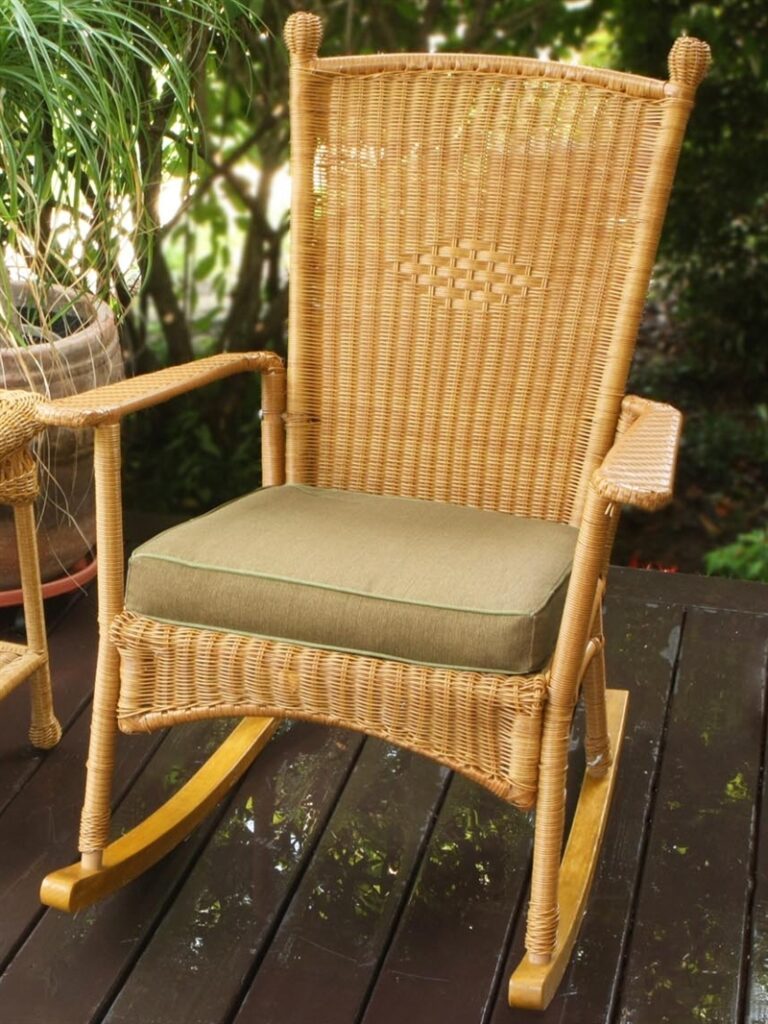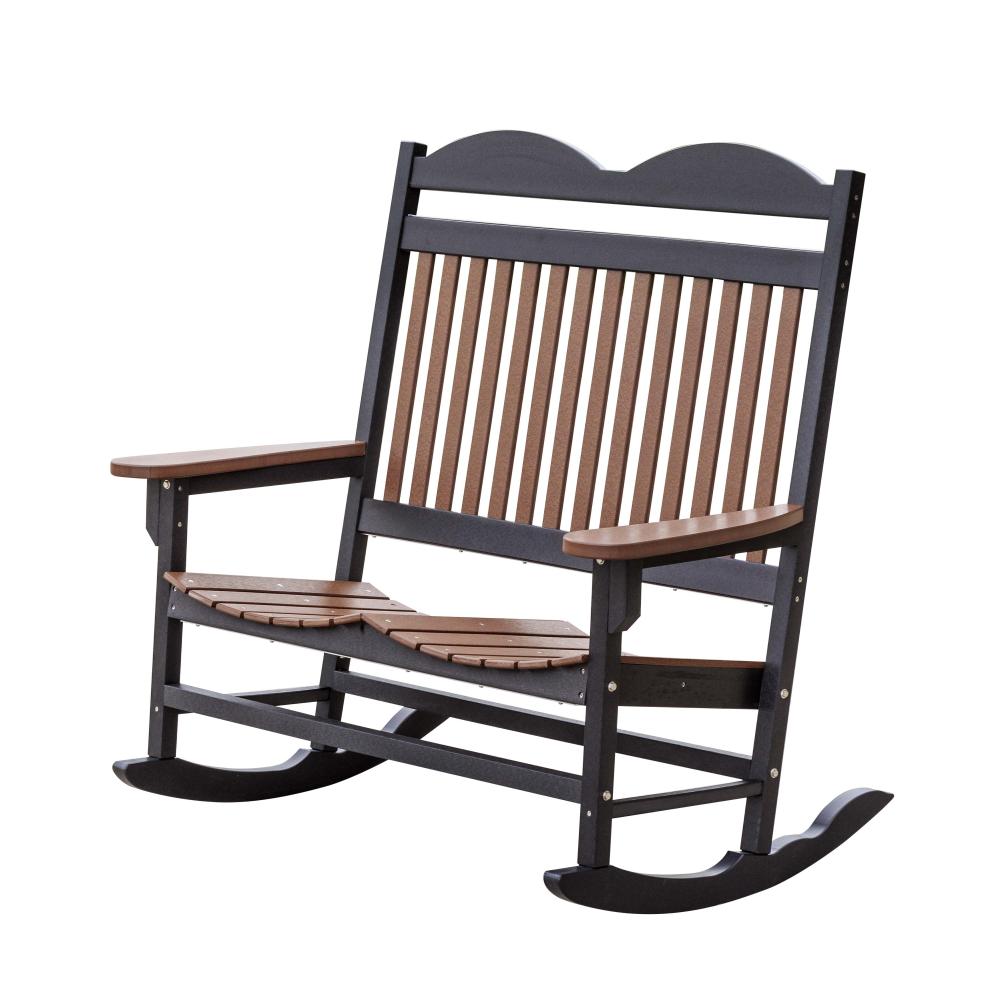Ten of the Most Sought-After Antique Rocking Chairs


Portside Classic Rocking Chair
Classic wicker rocking chair, 3 colors available. Lead time is 2-3 weeks.

Traditional Double Rocker
Heritage double seater traditional rocking chair.
Is there anything more iconic and American than the rocking chair? Since the early 1700s, they’ve been a vital part of our culture, and just about everyone knows someone who owns an antique or a vintage rocker. These chairs are found in many living rooms or front porches, and they have a rich and varied history.
The origins of classic rocking chairs, as we know them today, can be found in early 18th Century America’s gardens. Back then, they were little more than chairs set on runners. At first, they weren’t very popular. They came into use in mental facilities and hospitals to soothe and comfort patients. It wasn’t until the Shakers began to build them that America took notice of them, and their usage skyrocketed.
Over the years to follow, many styles were developed to meet the demands of the American people. Wicker rockers became popular during the Victorian era, both indoors and out, and various regions of the United States became known for the types of rockers that were produced there. For example, the Boston or Salem rocker was found in New England while the solid, blocky mission styles of rockers were crafted in the Spanish missionaries in California.
Today, many of these rockers have been lost, but those precious few still in existence are widely sought after by antique hunters and collectors. What is it about these chairs that’re so appealing? For many, it’s the thrill of the hunt. Finding a truly valuable rocker is a rewarding experience after a lengthy treasure hunt, one where you never know what you’re going to find at the next auction or the next market. For others, owning an antique is like owning a little piece of history, something to be carefully maintained, studied or displayed.
Stepping into the world of antique collecting can be a daunting experience. There is so much to see and so much to learn that you might wonder where to begin even. This is where it pays to make some friends and do your research. Often, the first step into the hobby (or vocation, as some might argue) is to talk to the people who are already in it. Visit antique shops, shows and auctions. Make some acquaintances and some friends, and ask them about how they got started.
Read as many books as you can. Your local library is an excellent source of information about antique furniture, and a decently-sized library is sure to carry a few guides to give you an idea of how much pieces are worth in today’s market. Don’t be afraid to look online too. There’s a treasure trove of information just waiting to be cracked open!
Finally, consider joining a collecting club. If visiting shops and shows makes you nervous that you’re about to be conned into buying something, and you don’t have the time to sit down and read book after book. and then try a club where you can socialize every once in a while and get to know people in a pressure-free situation. In a club, you’ll find people who are there for the passion of collecting, rather than the profit.
All of these sources combined should help you to get your foot in the door. They should also help to teach you about what to avoid. One of the greatest fears of every collector is paying far too much for a piece that turns out to be a replica or a fake. Admittedly, fakes and forgeries are fairly rare in the world of antiques, but replicas get mistaken for genuine pieces all the time.
There are ways to prevent this from happening to you. An excellent antiquing article written by Heather Kolich contains some details about Spotting Real Antiques, Fake Antiques, and Reproductions. First, do your research on the piece that you’re interested in purchasing. Look for any of its tell-tale characteristics in construction, such as the style of the back or the legs. If something seems out of place, trust your instincts. It probably is.
Visually inspect the piece before you lay down any money. Look at the quality of the wood, the joints, and the hardware. Our forefathers sure didn’t use particle board or composite wood to make their rocking chairs! Nails are an especially good indicator, as there were different styles of nails used depending upon the manufacturing technology available at the time of the chair’s construction.
Also, remember that wood darkens and shrinks as it ages. If the wood looks fresh and new, when the chair is being listed as one hundred years old, it is most likely a replica and a mistake.
So now that you know a little more about antiques, in general, you might be wondering just what kinds of antique rockers are the most sought-after.
Boston or Salem Rockers
As you might have guessed from the name, this style of the rocking chair was developed in New England, sometime around the middle of the 19th Century. As a point of interest, the Boston chair (without the runners) was developed a century earlier and doesn’t seem to have much in common, history-wise, with the rocker that’s been given the same name. The rocker was derived from the Windsor chairs early in the 19th Century, and its design is partially attributed to a man named Lambert Hitchcock, although there were many manufacturers of these chairs.
The rocking chair is characterized by a wooden seat that is curved, down at the front and up at the rear. The arms of the chair match the curvature of the seat, and its back has six to nine long spindles with a large crest rail. The back also has a slight outward bowing to it, allowing for a comfortable sit. The wood chosen was maple with a pine seat, and a decorative painting often adorned the cresting rail, depicting images of fruit and flowers. Without the arms, the chair was called a “little Boston rocker,” and if it had a low back, it was known as a “Salem rocker.”
- One Boston rocker, listed as 19th Century American, with grain painted, gilt stenciling and a scenic, decorative crest with a rosewood-grained seat is worth $750.
- Another Boston rocker, painted with a brown background, adorned with gold, yellow and green flowers painted on the side crest rail, with a large seat and canted center, is worth $295.
If you’re thinking of adding one of these beauties to your collection, be sure to consider the basic design before purchasing it. Some chairs are more primitive than others in design, while others have more gracefully-shaped seats and finely turned legs or arm supports.
Rustic Rockers
Distinctive in style and perfect for any log cabin or hunting lodge, rustic rockers have been around since about the first quarter of the 19th Century. They can be found fairly readily in the antiques marketplace, often made by craftsmen local to the area. Rustic rockers are often sturdy and dependable, made to last using small trees and branches. Rustic furniture takes the branches and the wood while it’s still green and pliable, bending it into the desired shape, then letting it dry out.
The style of the rustic rocking chair spread throughout America and Canada both, especially in the regions of the Adirondack Mountains, where people took their vacations in hunting and fishing lodges.
But just how valuable can they be? Very valuable.
- One model made in America in the late 19th Century or early 20th Century features bent wood, a shaped coiled back joined to bent arms on a splint seat and legs. It also has coiled seat supports, an old, worn and painted surface, and some small signs of repair to its back. It’s worth $920.
Windsor Rockers
This model of rocking chair is one of the most popular and sought-after models on the marketplace today. Fortunately, it’s also rather easy to find. Just beware of what you’re buying when you seek out this rocking chair model. While some were originally crafted as rocking chairs, many of the Windsors available started out as chairs and then had rockers added to them, which will decrease their value.
Since they’ve been around for so long, and because they have been so popular throughout the years, there are many, many different styles of Windsor chairs, and the style of the rocker will determine its name. For example, there are Bird Cage Windsors and Comb Back Windsors.
- A Windsor rocking chair, listed as being crafted in Pennsylvania, features a comb back, mixed wood construction, a scrolled crest rail, and a bulbous stretcher and arm supports. It’s worth $1,275.
- Another model of Windsor chair, hailing from the New England states, has a barrel crest rail with applied scroll arms, bamboo turned supports, a shaped seat on splayed bamboo turned legs, and old reddish-brown paint with yellow pin-striping. That one is worth $1,380.
L. and J.G. Stickley Rockers
These rocking chairs have a rich and vibrant history. The company is still alive and thriving today. You can even visit the Stickley website to read their personal story, in their own words. This company was founded by the Stickley brothers, who came into fame during the early 20th Century with their Mission-styles of furniture. The Mission has a very distinct and easily-recognized style, and was especially popular out in California. There, the heavy construction and solid wood went well with the décor of Spanish missionaries.
- An L and J.G. Stickley rocking chair with slatted bow-arms, a drop-in spring seat and a handcrafted label can cost anywhere from $3,000 to $4,000, depending on its quality and how well it’s endured throughout the years.
Charles Rohlfs Rockers
Born in 1853, Charles Rohlf was an American furniture craftsman whose designs combined Arts and Crafts forms with Art Nouveau decoration, making for solid pieces with touches of graceful adornment, such as fretwork and sinuous, carved motifs. Most of his furniture is made from oak wood. He opened his own workshop in Buffalo, NY, in 1898, and it remained in business until 1928.
Today, one of his rocking chairs is safely housed in the Carnegie Museum of Art, and this fine example showcases his distinctive, unique style that so wondrously blends solidity with soaring grace. Unfortunately, due to the handcrafting of his pieces and the exquisite workmanship, his pieces were regarded as expensive during his day and age.
- A rare Charles Rohlfs carved rocking chair, measuring 36 inches wide, with a carved “R” and a date of 1902, is worth $12,000 to $18,000.
Arts and Crafts Rockers
When the Industrial Revolution hit civilization, the Arts and Crafts movement rose up in response to the dominance of machine-made furniture. In comparison to the furniture of old, the modern goods were shoddy and churned out in debased revivalist styles for mass consumption.
William Morris, one of the forefathers of the Arts and Crafts movement, called for artists to return to pre-industrial methods of crafting. There were communal organizations similar to medieval craft guilds, and with this method, both artist and object would be reunited.
While there are many opinions about the naiveté and practicality of these philosophies, there is no denying that the furniture produced by the Arts and Crafts movement was clean, simple and solid in design. It was “honest” craftsmanship. It was also widely influential, inspiring other movements and modern furniture, and it was priced so as to be affordable to the common man.
- A rocking chair, featuring oak wood construction, Mortise and Tenon joints, pegged and an un-upholstered seat is worth $354.
- A Plail Brothers barrel rocking chair, with a drop-in spring seat and rail backing, unmarked, is worth $1,500 to $2,500.
Shaker Furniture
Perhaps the most influential group in the history of the rocking chair, the Shaker community has done more for the promotion of the rocker as a vital part of the American household than anyone else. The Shakers were an ascetic communitarian sect of Christians who came to the United States from Britain during the time of the Revolution. They were a simple people who pursued self-sufficiency and independence, and during the beginning of the 19th Century, they began to manufacture their own furniture and developed their own designs. They promoted simplicity and functionality, believing that “beauty rests on utility.”
Their best-known pieces are their chairs, most of which feature a ladder-back design derived from British country furniture, but they are slimmer and taller. A thin crest rail was often used for suspending a cushion for additional comfort.
Shakers are widely regarded as the forerunners of modernity. Their style of furniture remains highly popular, even in today’s market.
When seeking a Shaker chair of your own, take note of the style of the legs. Chairs that were manufactured for sale outside of the community into the secular world were marked with metal mounts attached to the rear legs.
Slat-back chairs were another popular design in the Shaker models of chairs, enduring for more than 200 years. There are a lot of reproductions in the market that can be mistaken for authentic, original pieces. Beware of sharply turned posts and sharp-edged rockers that hint that the chair is much newer than it should be.
- According to Kovels’ Antiques and Collectibles 2015 price guide, a Shaker ladder-back rocking chair constructed from maple, with a cane seat and shag-rug seat, made in Union Village, near Lebanon, Ohio, is worth an amazing $67,260!
Conclusion
As you can see, many of these rocking chairs are well beyond the price range of most people, but for those who can afford them, they are well worth the cost. Their classic designs and durable construction are fragments of American history to own and cherish. Buying an antique rocker can be an intimidating prospect, but with time and research, you can enhance your own home with your own treasure.
You might also consider making an investment in a new rocking chair. All antiques once started out as brand-new, after all. There are many different styles available in many online sites, such as the Rocking Chair Company, which can provide a high-quality chair at only a fraction of the cost. With time, you might even pass it down to your children or grandchildren, and in a couple of hundred years, there’ll be a new antique on the market!
